|
An Inventory of Marx Playset Figures and Accessories Manufactured from 1951 to 1979
Appendix B-3 - Playset Accessories
of the American Revolutionary War |
Contents of this web site may not be reproduced or duplicated for use on the Internet or for commercial purposes without permission by Eric Johns.
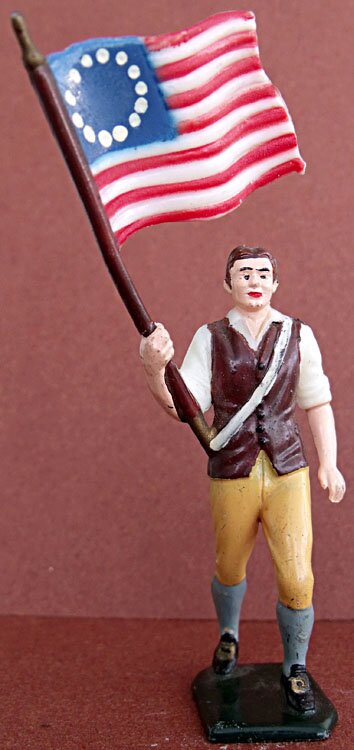 Table of Contents
Click on the section or page to move to it.
|
| This Page |
| Buildings |
| Stockade |
| Terrain pieces |
| Fence |
| Flags |
| Cannons |
| Small Accessory Groups |
| Other Pages |
| Page 1 - Playset Figures |
| Page 2 - Other Playset-related Figures |
| Page 4 - List of Playsets |
| Back to Revolutionary War Table of Contents |
| Back to Main Table of Contents |
Buildings
Tavern
From the outside, this lithographed building made of pressed steel (commonly called tin) appears to be an English-style pub with the name "Sons of Liberty." There is no question that rowdy American rebels frequent it. Inside, however, the lithography makes it look more like a formal room in the house of an English gentleman. Besides the two lower windows in the front, the inside shows another window on the left (as you look in from the back) and a fire place on the right. Overhead is a chandelier, and on the walls are three paintings, two of white-wigged aristocrats and one of a typical English landscape.
The building measures 10 inches wide, 4 inches deep, and 6-1/2 inches to the peak of the roof, with another half inch for the chimney. It is three sided with a floor and an open back. Unlike other 3-sided Marx buildings, this one has a partial back, leaving an opening on the backside of about 9-by-3-1/2 inches. That's still plenty of room to set up your Colonial furniture and place figures inside, and the partial backing provides a little extra support for the building.
As most Marx structures, it is a smaller scale than the playset figures; though a second story is shown on the front, no second floor is shown on the inside lithography. Interestingly, the building is identical to the one Marx included in its nativity set, with the only differences being the tavern's chimney and, of course, the lithography.
Overall, it is an attractive piece and provides the perfect setting for a good anti-King, give-me-liberty-or-give-me-death speech.
| Recent Price Lines I have noticed | ||||
| $34 | January 2015 | Ebay | from Heritage playset, nice deal for buyer | |
Click here to see a view of the complete back. Or click here and see a close-up of the back.
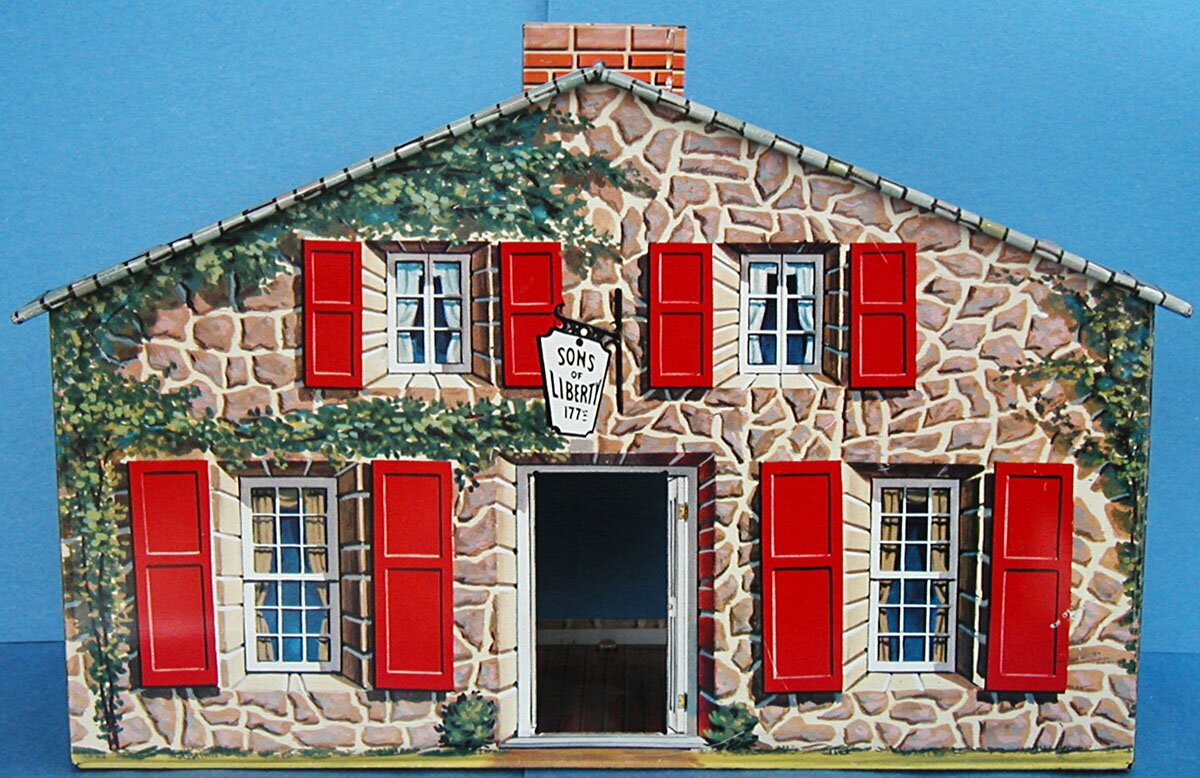
Two-story blockhouse
The Revolutionary War playset #3408 and Fort Mohawk playset, both issued in 1959, had some very different accessories than previous sets. They did not include the tin litho taven, tin litho rock walls, or tin litho flag. Set #3408 did not even have the Revolutionary War cannon (as described later on this page). However, they did introduce an attractive 2-story, self-standing blockhouse.
The large blockhouse came in seven pieces and was relatively easily snapped together. Both the inside and outside are nicely detailed, with an open back that allows access to the inside. It came in hard plastic, both tan and dark brown. The Fort Mohawk blockhouse -- I am unsure whether it was tan or brown -- had the name Fort Mohawk heat stamped on the upper front in yellow; the #3408 set version had no name on it.
This block house was used in a few other playsets, such as Fort Pitt (also in 1959) and Fort Apache. Like Fort Mohawk, the Fort Pitt blockhouse was heat stamped Fort Pitt. The Fort Apache one had no name on it -- though it has an undetailed portion of the front facade to stamp a name -- and added a hole in the top of the cupola to place a flag pole.
The blockhouse shown below is the one from a Fort Apache playset, but except for the name looks identical to the Fort Mohawk version.
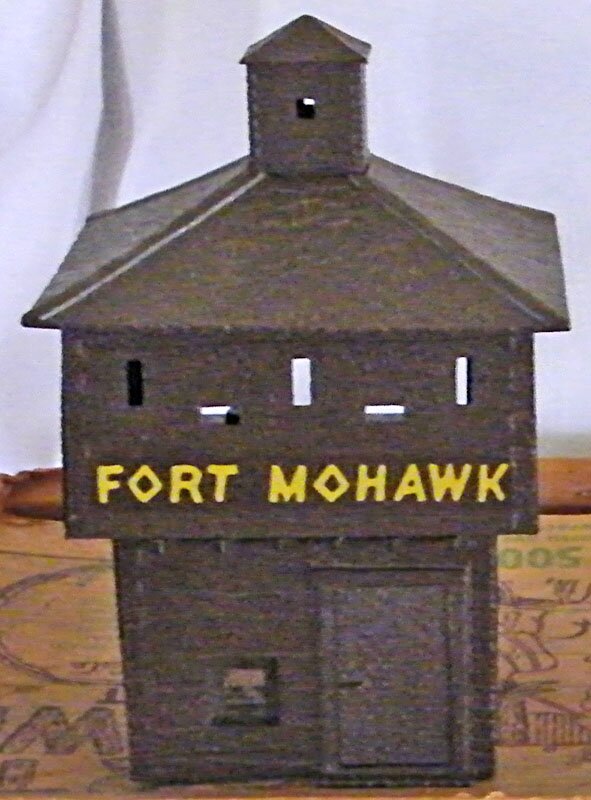 |
2-story stand-alone blockhouse The Fort Mohawk playsets included the stand-alone blockhouse version shown at left. In the other Revolutionary War set that included this blockhouse, there was no name heat stamped on the front, but unlike the Fort Apache version shown below, the blank name space was fully detailed as logs, the same as the rest of the blockhouse.
Fort Mohawk version photo courtesy of collector Butch Parker.
|
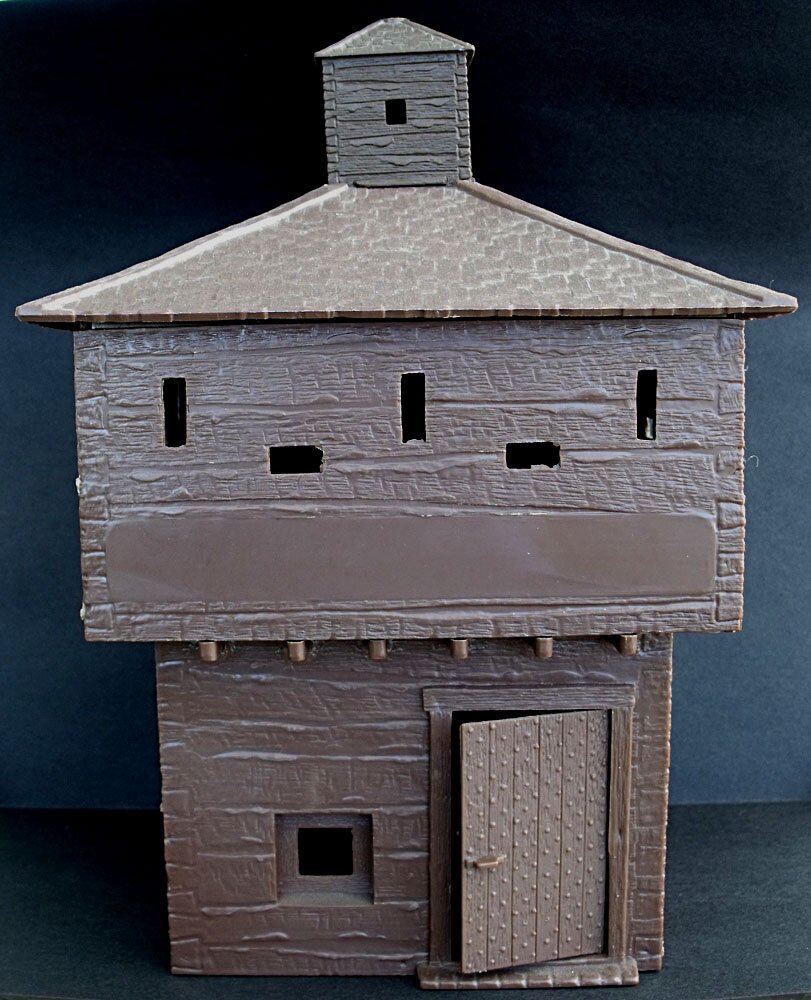 |
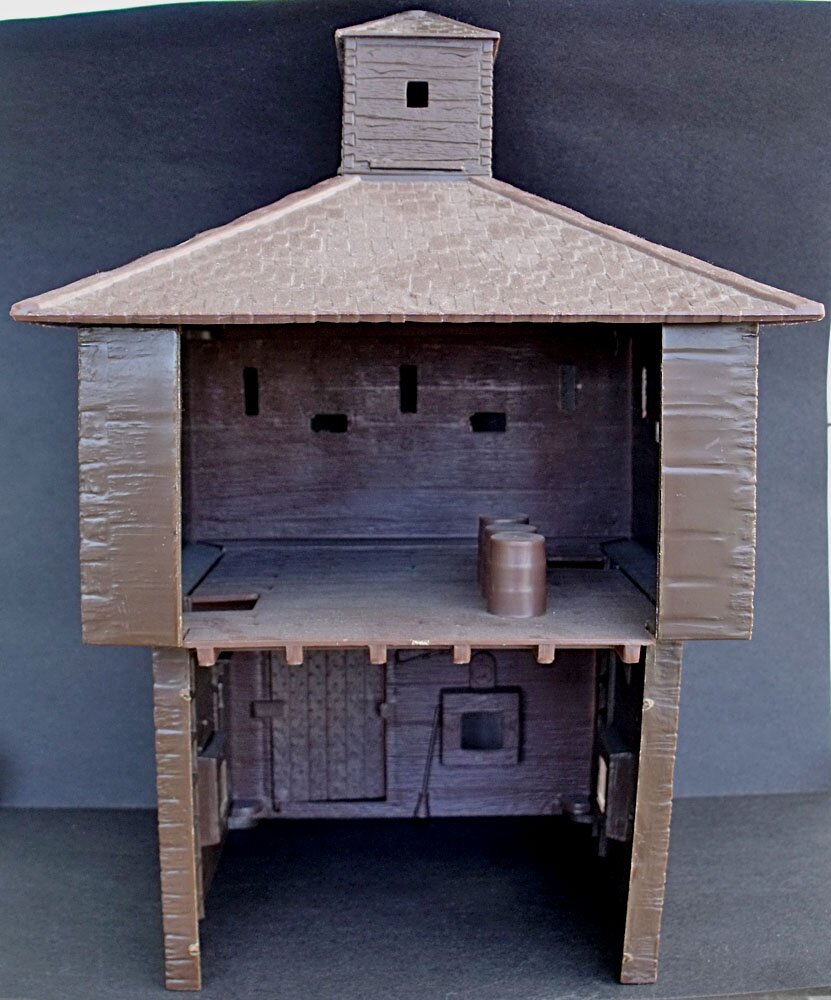 |
| Version of stand-alone blockhouse used in one Fort Apache playset. (front and back views) Note that in the Fort Apache version a hole for a flag pole is located in the top center point of roof (not seen in photos), which the Revolutionary War versions did not have. |
|
| Recent Price Lines I have noticed | ||||
| $115 | October 2012 | Ebay | very minor damage | |
Cabin with center chimney
This is one of the most difficult to find Marx tin litho buildings, another #3408 oddity. It came only in that 1959 playset, two in each playset. It was never used in any other playset. If you can find it you are doing good,
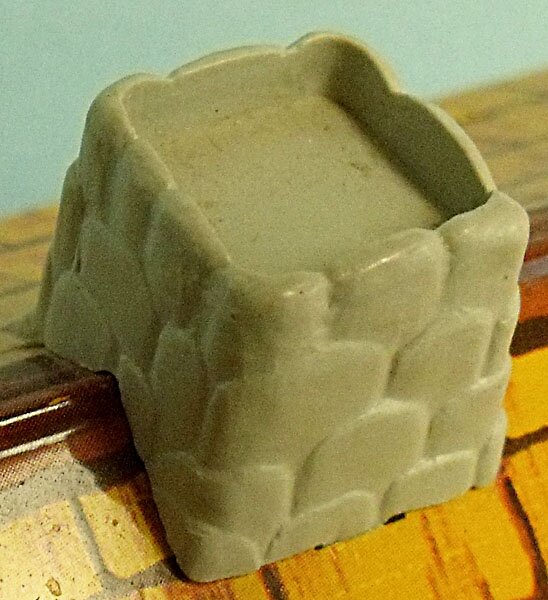 if you can find it for sale you are doing excellent, and if you can find it for sale under $200 you are performing miracles. It's the only Marx cabin that has a center chimney, the same as the tavern above. Otherwise, it uses the same pattern as the down-sized cabin in Wild West playsets, and its litho is also pretty much the same.
if you can find it for sale you are doing excellent, and if you can find it for sale under $200 you are performing miracles. It's the only Marx cabin that has a center chimney, the same as the tavern above. Otherwise, it uses the same pattern as the down-sized cabin in Wild West playsets, and its litho is also pretty much the same.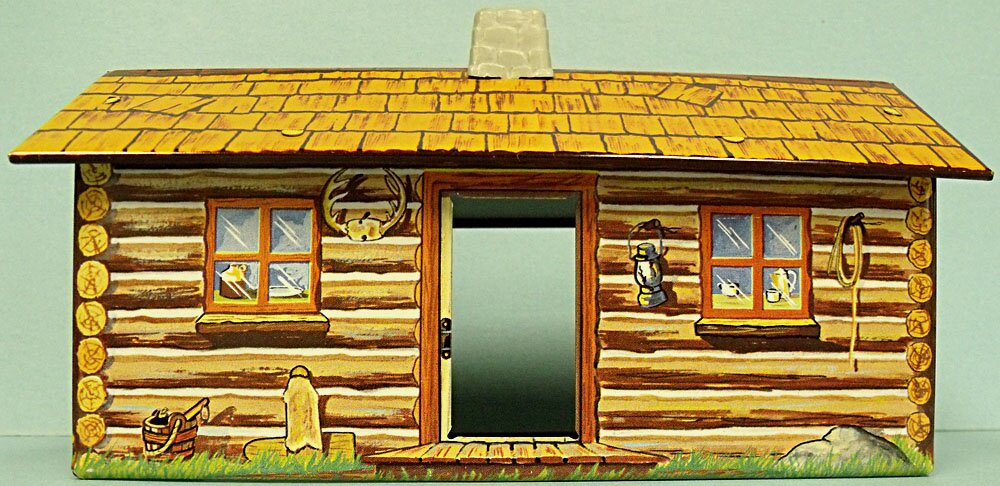 |
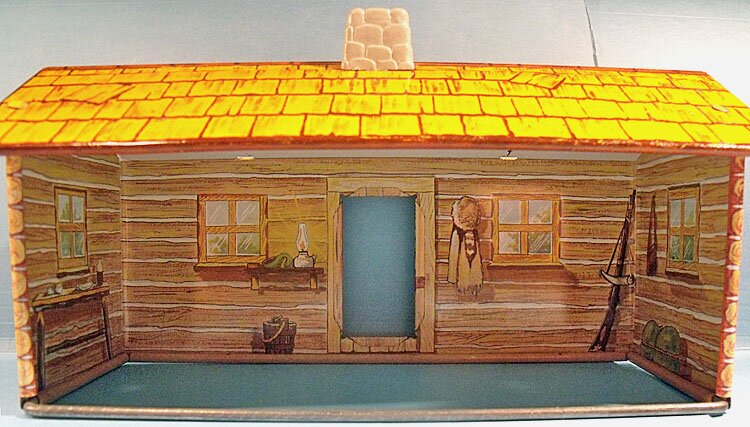 |
| Cabin with center chimney. Top photo courtesy of David Schafer. |
| Recent Price Line | ||||
| Cabin with center chimney | $255 | March 2011 | Ebay | |
| Cabin with center chimney | $430 | Sept 2011 | Ebay | "mild surface rust on roof" and missing back bar - good price for seller |
| Cabin with center chimney | $158 | October 2011 | Ebay | Great price for buyer |

Stockades
Jungle stockade
This fort was first used in Marx Jungle theme playsets and later in Daniel Boone sets. The gate and walls are noticeably smaller than Fort Apache pieces, and Marx used it in playset #3408, most likely to reduce costs. The 54mm figures could almost look right over the top of the stockade walls.
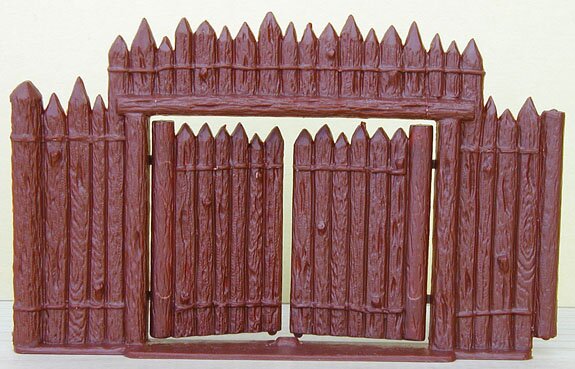 |
 |
| Jungle-style fort gate | Jungle-style fort wall (ouside) |
 |
 |
| Inside of wall without rampart | Inside of wall with rampart |
Fort Apache Stockade
According to Issue 3 of the magazine Toy Soldiers and Collectibles, the 1959 Fort Mohawk playset had a Fort Apache style stockade with a gate and nine walls. The gate reportedly was the same as the basic Fort Apache gate, but had no name above it. The gate and walls below actually came from a Fort Apache set, but except for the name over the gate, they look the same as the items that would have been in a Fort Mohawk set.
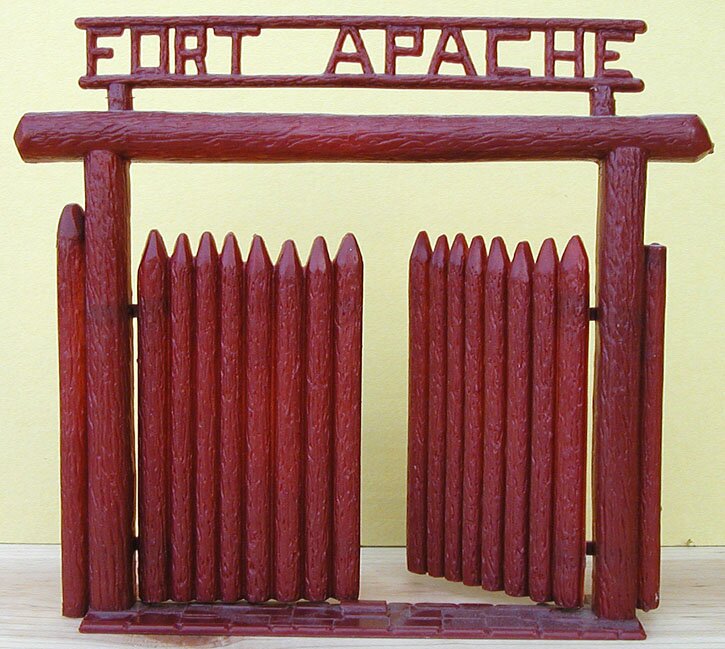 |
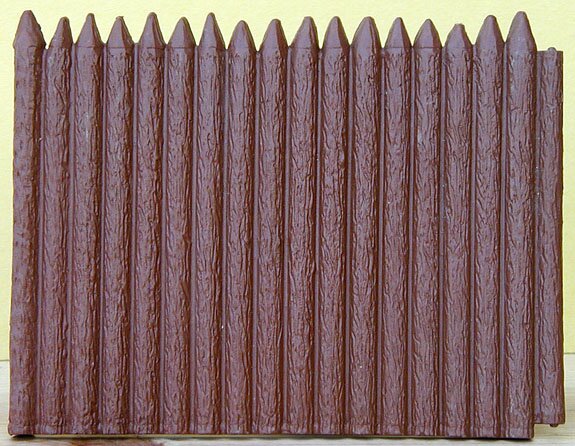 |
| Fort Apache gate Fort Mohawk had no name over the gate. (PL-342) |
Outside of Fort Apache style wall |
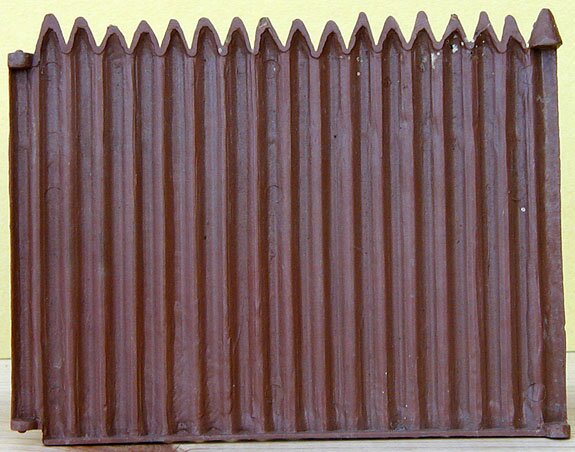 |
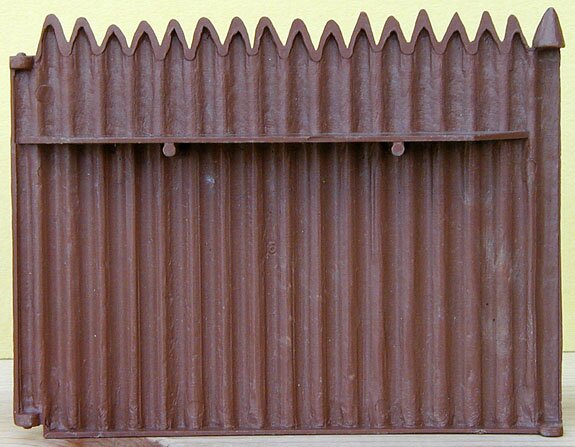 |
| Inside of basic Fort Apache style wall (PL-890) |
Inside of Fort Apache style wall with rampart I am not positive that Fort Mohawk had walls with ramparts. (PL-341) |

Terrain pieces
All trees used in the Revolutionary War playsets had been used earlier in Wild West, Civil War, and other sets. Commonly produced in hard plastic in the past, they were revised to soft plastic here. The 1972 Heritage set included only the "stand of four trees," which Marx made to be broken into two 2-tree pieces.
"A" tree
PL-524
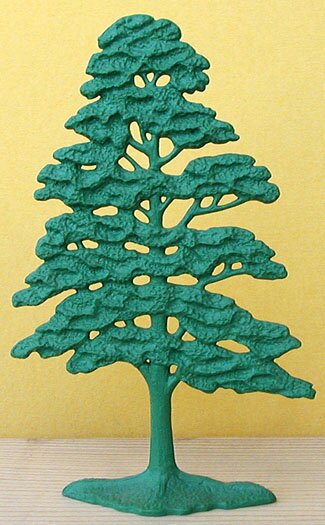
Trees and Stumps
PL-332 and PL-332A
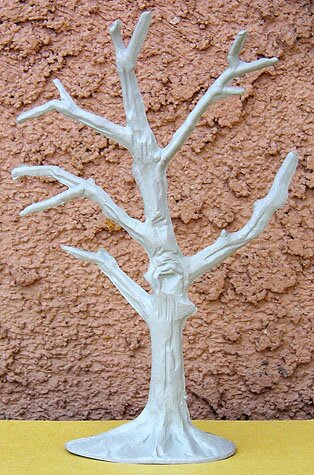 |
 |
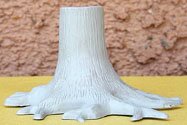 |
| Dead tree | Large stump | Small stump |
Stand of trees (sometimes called Northern trees)
PL-?
These trees were used in only one Revolutionary War playset, the 1972 Heritage set.
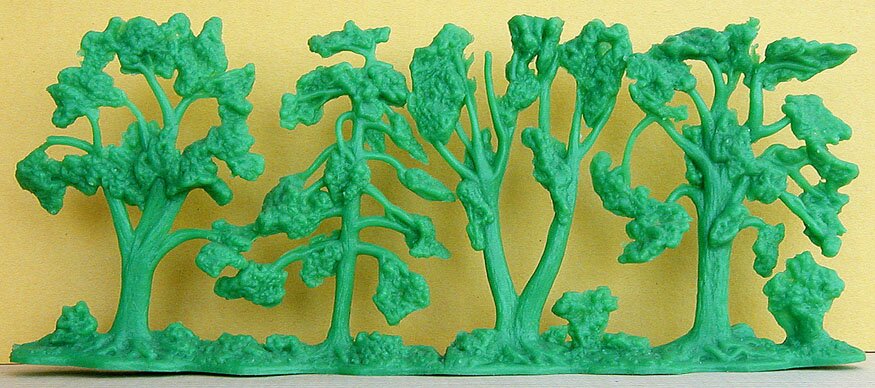 |
| Stand of four trees (Made to be divided in middle if desired) |
Rocks
Rocks were plentiful in Revolutionary War playsets. The two boulders shown below were recycled from numerous Wild West sets, having been been in use from the early 1950s. Two of the rock piles shown were included in some Civil War sets, but the "rock pile with no bulge" was new in this set.
The names for these rocks were created by Tim Geppert in an article in PFPC Issue 22 that provided information on Marx rocks and trees.
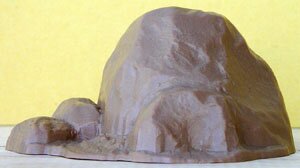 |
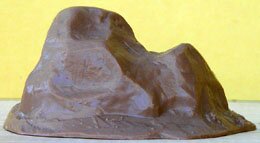 |
|
| Large boulder 3 inches wide, 1-1/2 inches tall |
Small boulder 2-1/2 inches wide, 1-1/4 inches tall |
|
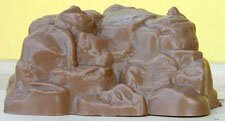 |
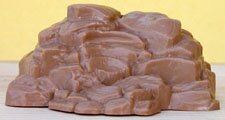 |
 |
| Rock pile with no bulge 2-1/4 inches wide, 1-5/8 inches deep |
Rock pile with center bulge 2-1/4 inches wide, 2 inches deep |
Rock pile with left bulge 2-1/2 inches wide, 1-/7/8 inches deep |

Fencing
Revolutionary War sets were inconsistent in fencing, with at least three types of fence included in one or more of the sets.
Split Log Fence
PL-147
The split log fence shown below is from Wild West sets. As many as six pieces were included in the earliest Revolutionary War sets in white or cream. It is 6-1/4 inches wide and 1-7/8 inches high.

Tin litho rock walls and corner posts
PL-?
The tin litho fence or wall below -- with the lithography created specifically for Revolutionary War sets -- was clearly the most attractive, but also the most expensive to make. With different lithography, the wall had previously been used as castle walls in Medieval playsets. The tin litho part is a long 10-1/2 inches wide, 1-3/4 inches high, and 3/4 of an inch deep. The two plastic end caps add about 2 inches to the length, as well as a small amount to the height and depth.
For some reason, Marx made end caps that could be attached to only one tin litho wall, so that the two walls included in a set could not be connected to create one long wall. As shown below, the backside of each cap had slots for three tabs on the tin litho wall, at the top and on each side.
While a nice item, the color is a bit odd, in a very light shade. The end caps -- though they do not look like it in the first two photos below -- are flesh, and the tin litho wall is a light yellow/flesh/tan. I'll never understand why Marx used the color "flesh" so much!
 |
| Tin litho rock wall - one side, with end caps attached I'd call this the front side. |
 |
| Tin litho rock wall - the other side, with end caps attached I'd call this the back side. |
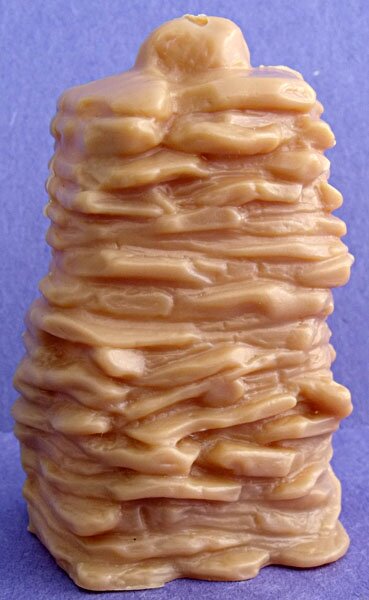 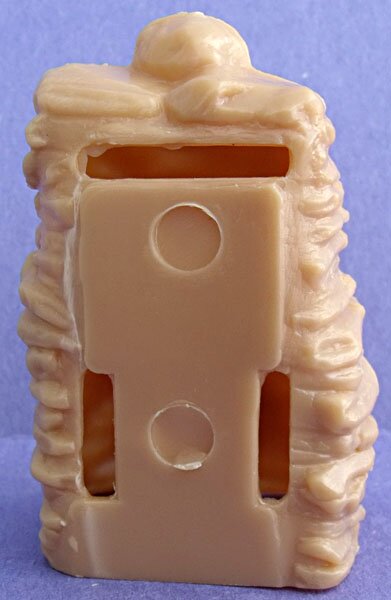 |
| End cap, front and back Three slots in back are for tabs on tin litho wall. End cap shown is re-issue. |
Plastic rock walls
PL-?
In the 1972 Heritage set, the tin litho walls were replaced with six low plastic rock walls, which were also in the Marx Flintstones Play Set, and therefore are often called the Flintstone walls.
The walls are just under 8-1/2 inches wide and about 3/4 inches high and deep. Re-issues exist.


Flag, pole, and earthen base
PL-346
Of seven Marx playsets in the Revolutionary War theme, five had Marx' usual tin litho flags. The company's playset set #3401 (the smallest of Revolutionary War sets) and #3762 (Fort Mohawk) came with an authentic-looking 13-star flag. A Sons of Liberty flag -- an imaginative flag created by Marx -- was in three sets: #3402 (the Johnny Tremain set), #3404 (the set with the most figures in it), and the Heritage set. Veteran collector Josh Petrie reports that he has occasionally seen the Sons of Liberty flag in #3401. The other two sets had no flags.
Flag poles and bases were in hard plastic gray. They were the versions created earliest by Marx, round log poles with rock pile bases. The bases are about 3/4 of an inch tall, and the poles are 6 inches. The tin litho flags are on the standard Marx flag.
The unfortunate Bristish Army had no flag in the world of Marx.
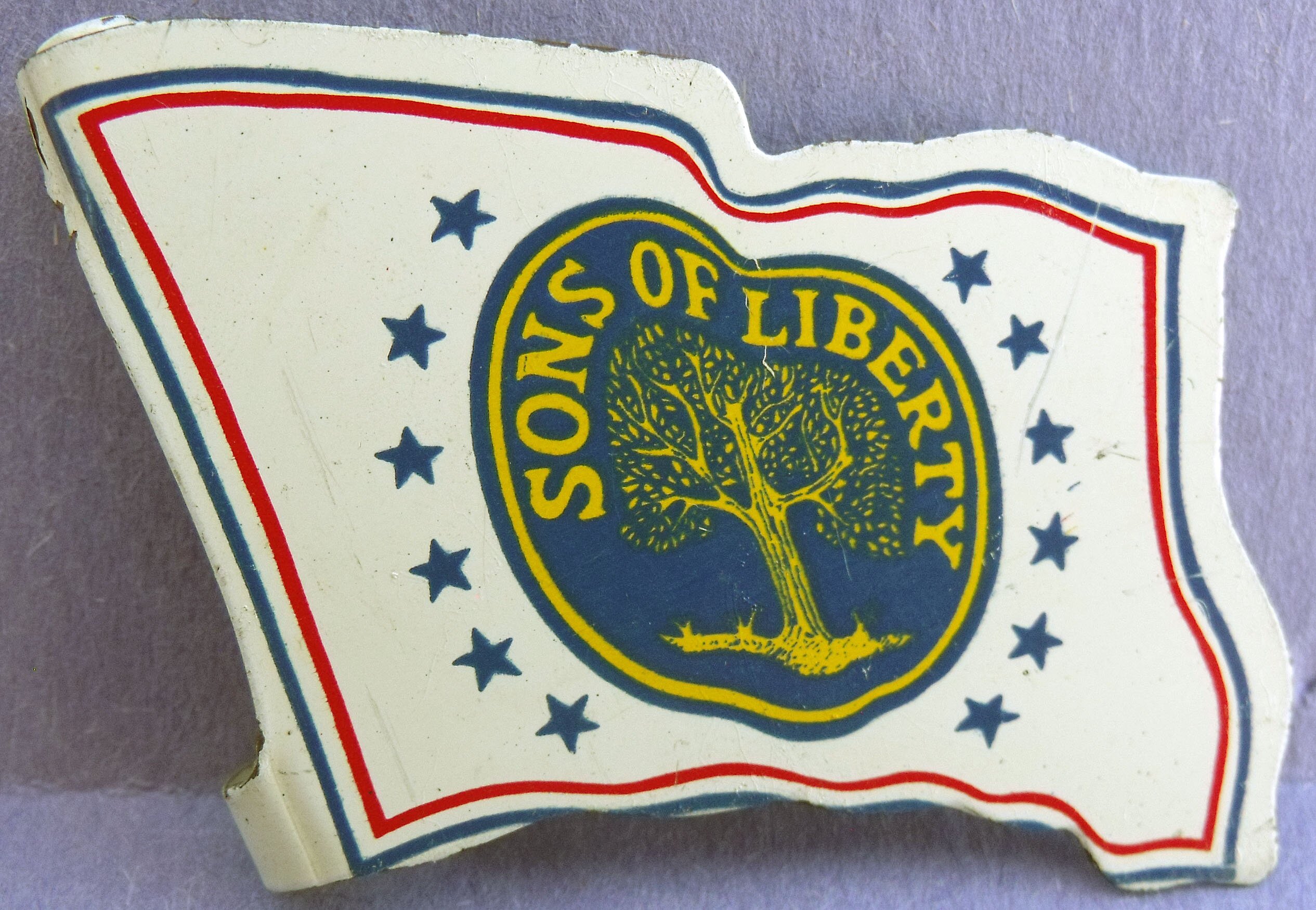 |
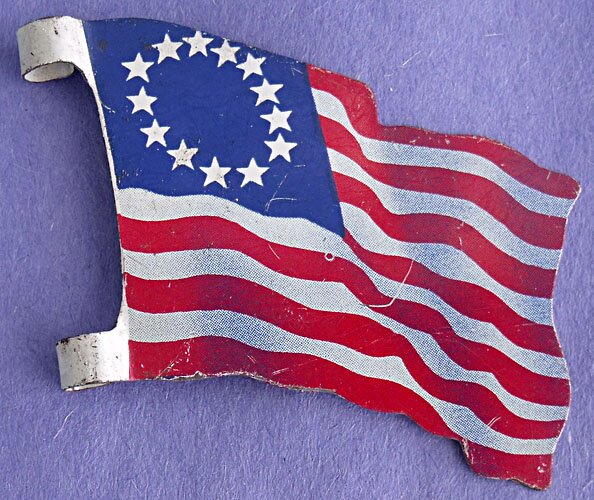 |
 |
| Sons of Liberty flag |
13-star flag Photo courtesy of Rich Eber |
Rock pile flag base |
 |
||
| Flag pole | ||
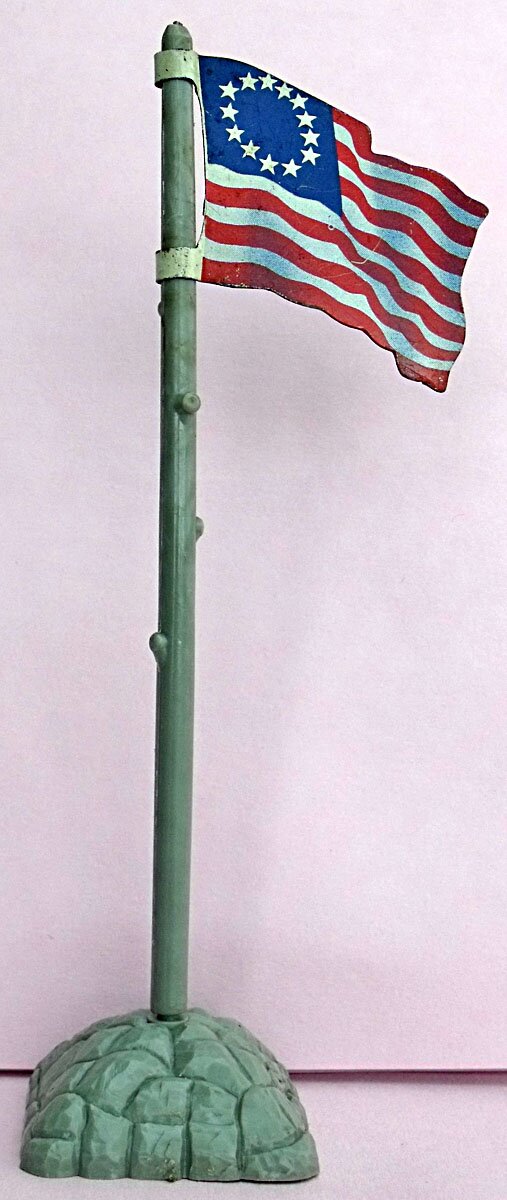 |
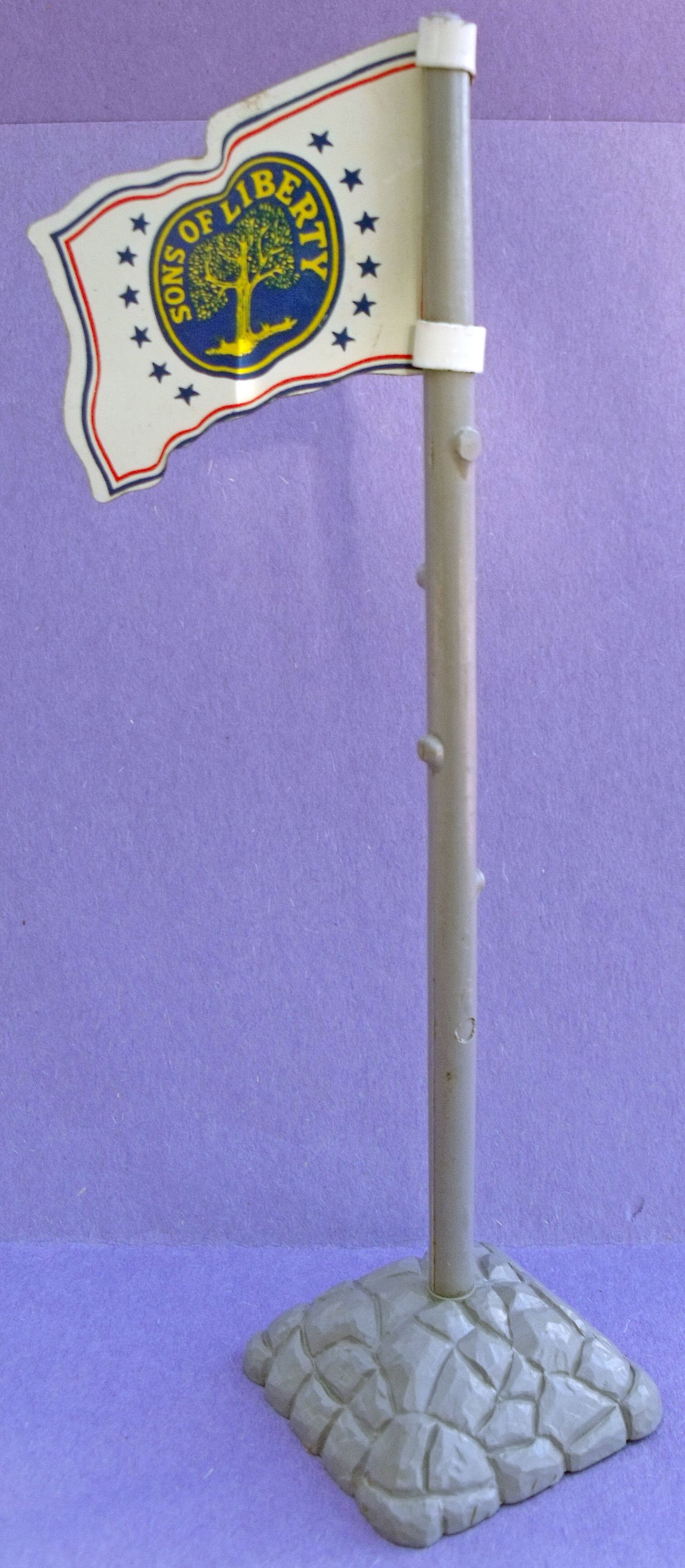 |
|
| Flag pole with 13-star flag Photo courtesy of Rich Eber |
Flag pole with Sons of Liberty flag |
|

Cannons
Revolutionary War Cannon with accessories
PL-876
One of the best things about the Revolutionary War playsets was the new ornate, firing cannon created for them. It is larger and more attractive than the standard Fort Apache cannon (see below) and was molded in a gold color. They are hard to find today and not cheap when you do find them. An original cannon shown below -- graciously provided by Kent Sprecher -- is from Marx' 1972 Heritage Revolutionary War playset, a later set that did not quite get the gold color right and did not include the firing mechanism with the cannon.
Cannon accessories are shown below, though the cannons balls to be fired from the cannon are not pictured. This is the one Marx cannon that actually needs the ramrod in order to push the ball into a firing position!
Re-issues are much less expensive, but come in silver and do not fire.
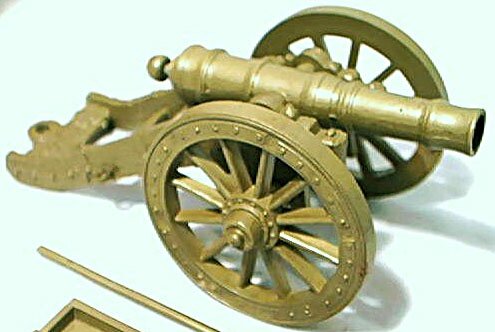 |
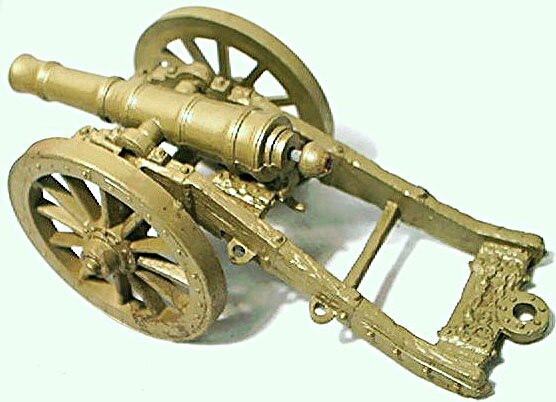 |
| Two views of gold Revolutionary War cannon from Johnny Tremain Play Set Photos courtesy of Mark Novack, Ebay brtcarguy |
|
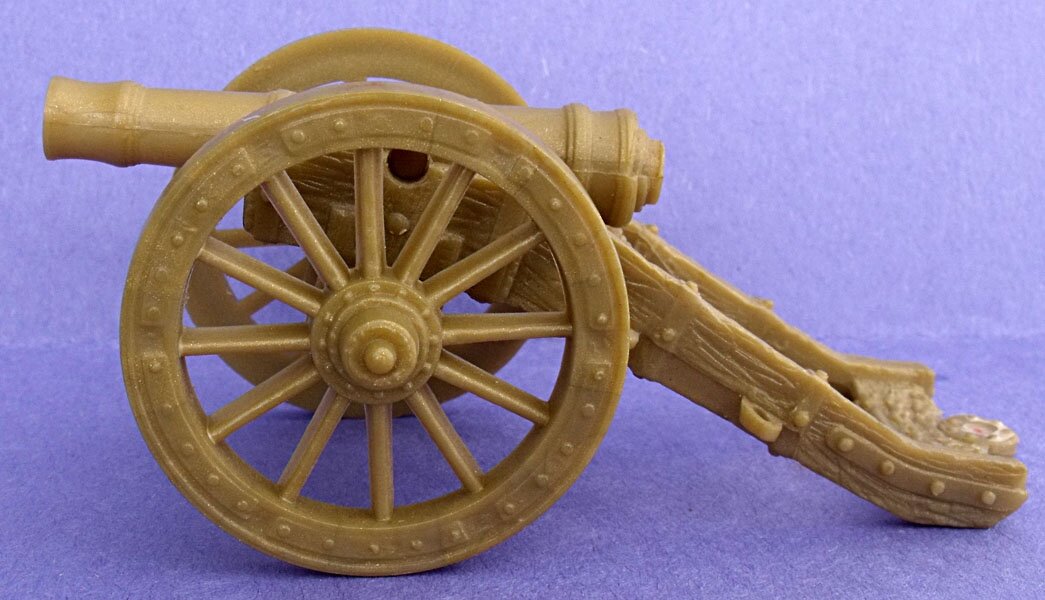 |
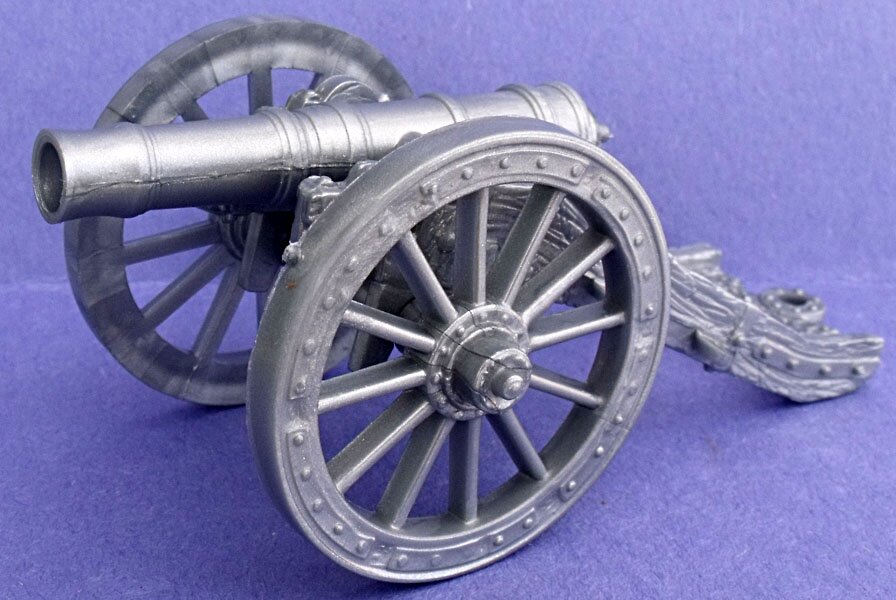 |
| Revolutionary War cannon From Marx Heritage playset. This 1972 set did not get the "gold" color quite right and did not include the firing mechanism, which should be seen at the back of the cannon barrel. |
Revolutionary War cannon Re-issue item, non-firing. |
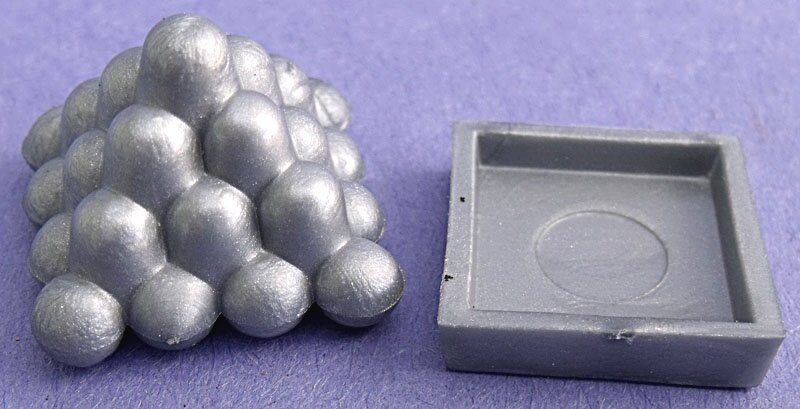 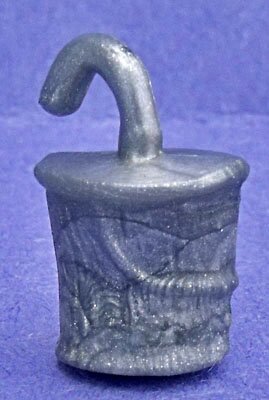 |
 |
| Bucket, pile of cannon balls, and tray to hold loose cannon balls Re-issue items. What appear to be oblong cannon balls appear round when viewed normally from above the pile. The tray holds cannon balls that can be fired from the cannon (not pictured). |
Cannon ramrod and swab re-issue items |
| Recent Price Lines I have noticed | ||||
| gold cannon, firing version | $51 | April 2013 | Ebay | no shells included |
Fort Apache Style Cannon
PL-411
Starting with Fort Dearborn and Fort Apache sets in 1953, Marx included this firing cannon in many of its play sets. As shown in the photo below, the cannon had a wire mechanism that fired miniature cannon shells. The cannon and shells were made in hard plastic; Revolutionary War sets cannons were either black or gray.
The 1972 Sons of Liberty Heritage set included a non-firing cannon without a spring, but was otherwise identical to the original cannon. This was most likely due to safety precautions and/or to reduce playset costs. The wire mechanism used to create a "firing" cannon is easily lost, so that many cannons manufactured as the firing version are now missing these wires.
The cannon is about 1-3/4 inches high and 4 inches long; the sprue of shells is also 4 inches long. I know nothing about cannons (even though my father was an Army artillery officer), but this Marx cannon is commonly referred to as 12-pound cannon.
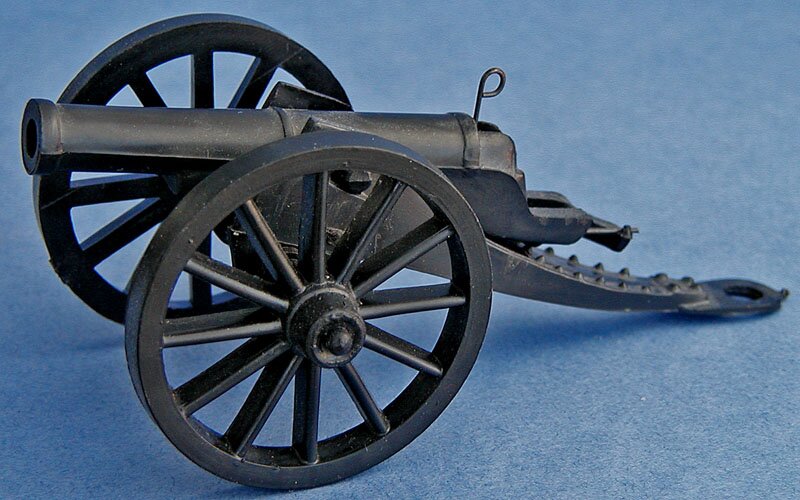 |
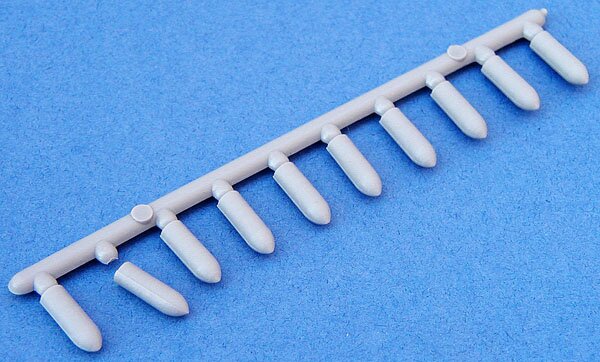 |
| Firing cannon (with wire firing mechanism) Cannons in Revolutionary War sets were either black or gray. |
Sprue with 10 shells Shells were either black or gray, matching the color of the cannon. |
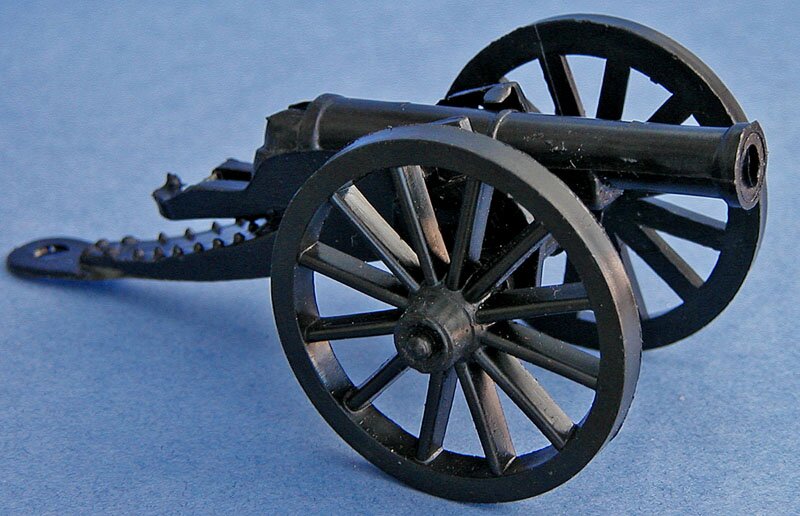 |
| Non-firing cannons were used for Heritage playset Same as firing cannon, but without spring. |

Small accessory groups
17-piece Revolutionary War Group
PL-875
This new accessory group had 17 pieces that made up of 11 different accessory items. For most sets, pieces were in a hard plastic and a unique color that collectors call "rose-maroon." Those in playset #3408 from 1959 were sometimes in light brown, and 1972 Heritage playset accessories were in what PFPC Issue 32 calls a "waxy dark brown."
At a quick glance this looks like a nice group of accessories, well made and creative. Unfortunately, many of them are far too small in scale for the figures. The chairs and spinning wheel are especially absurd. Moreover, what is one to do with chairs, stool, a table, a stretcher, and a spinning wheel when there are absolutely no figures that relate to them.
They are nice as background material -- or perhaps used to bar the door from a horde of British Redcoats -- and they can also fit nicely into other playset themes, including the Wild West and the Civil War. The table is a nice touch with papers, ink well, and feather pen. The cauldron, stack of muskets, and stretcher are also well done, with the stretcher molded to resemble a rough woven cloth
It's just too bad that they were not made a little larger and that a few figures were not made to utilize them.
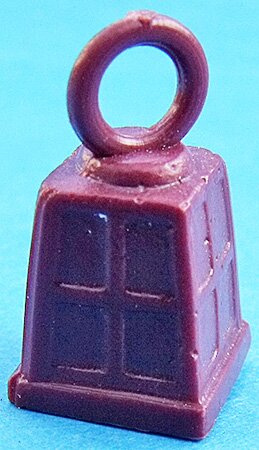 |
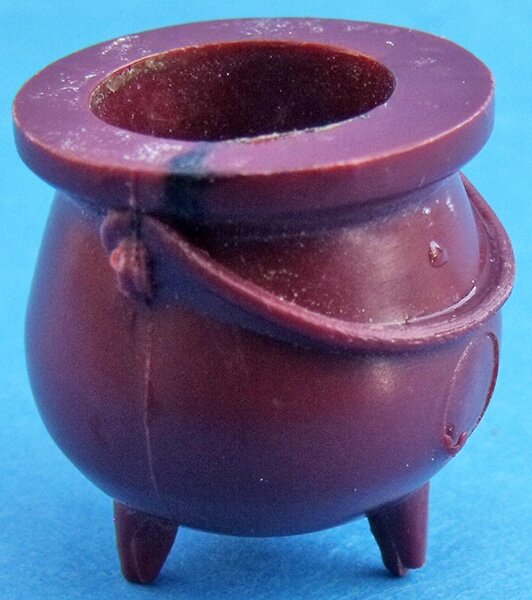 |
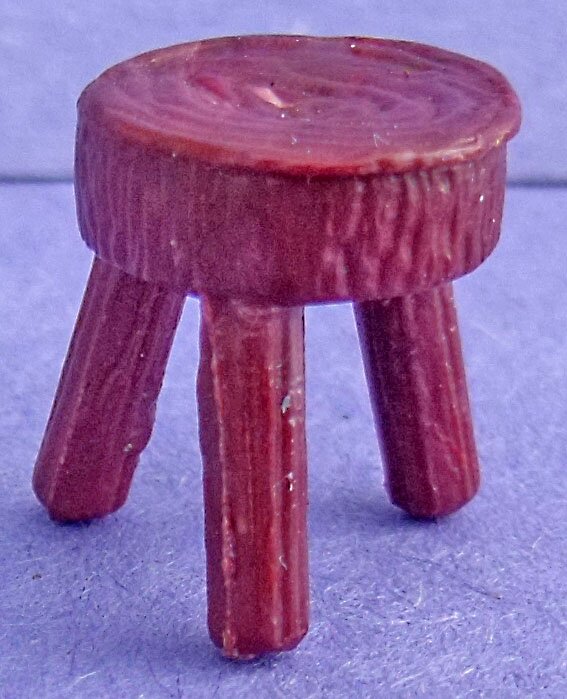 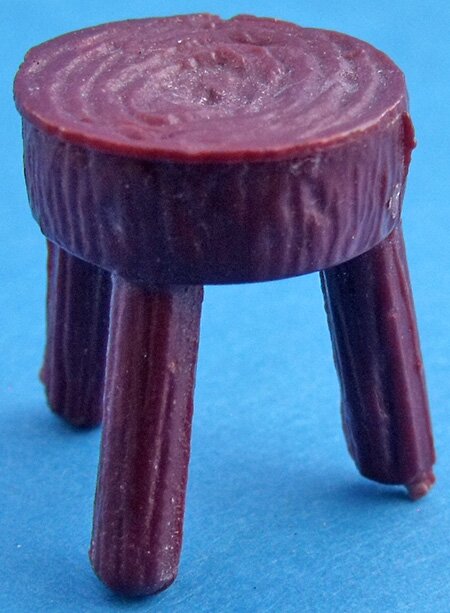 |
| 1. Lantern | 2. 3-legged cauldron | 3. 3-legged stool |
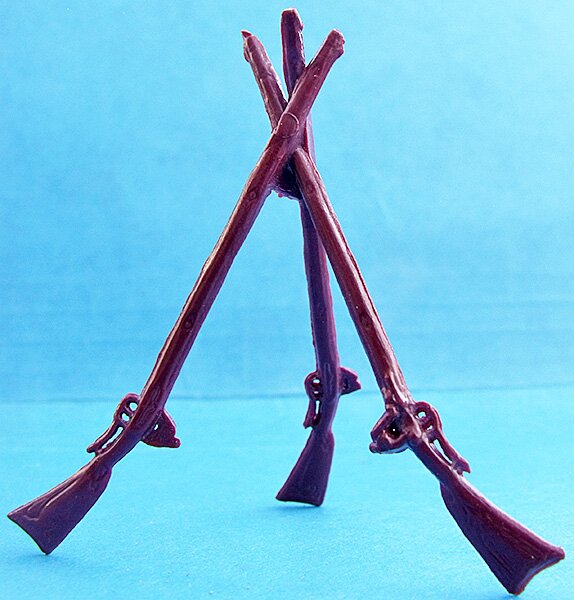 |
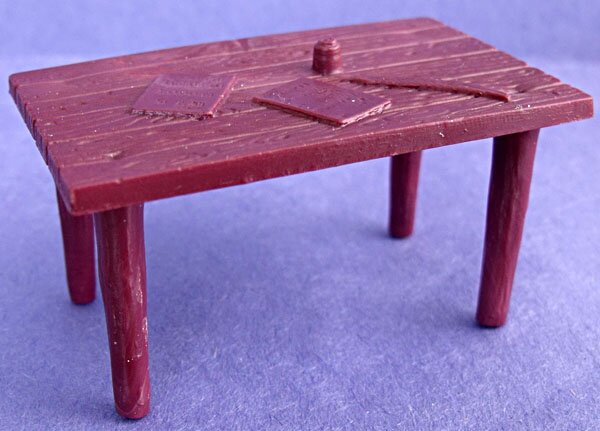 |
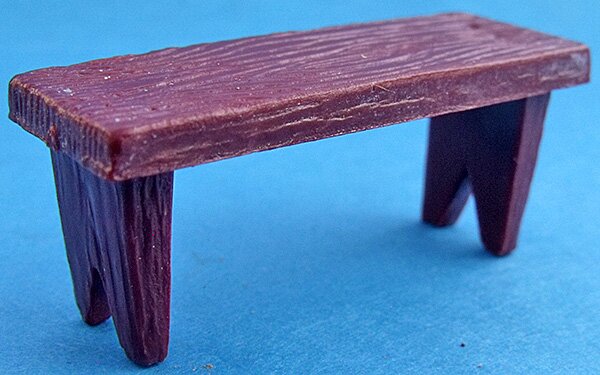 |
| 4. Stack of muskets | 5. Table with quill, ink well, and papers in maroon color |
6. Narrow bench |
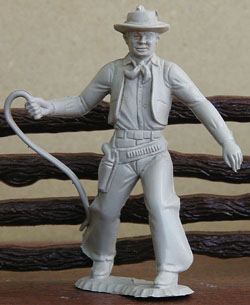 |
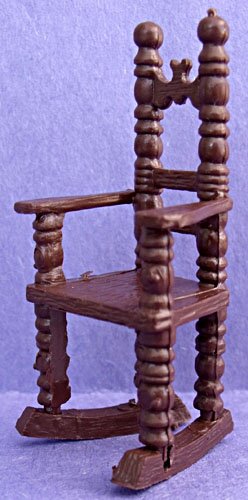 |
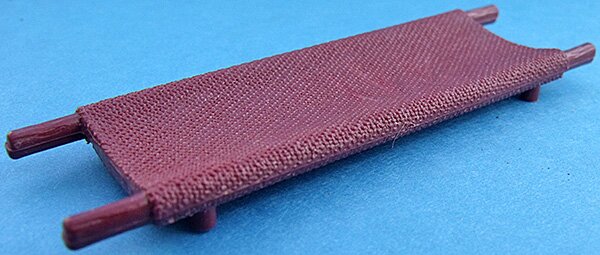 |
| 7. Small ladder back chair in light brown color |
8. Rocking chair (chair plus two rockers) in re-issue brown |
9. Stretcher |
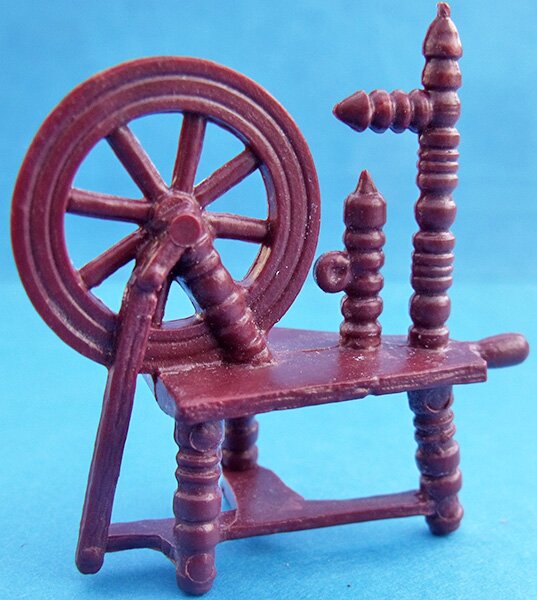 |
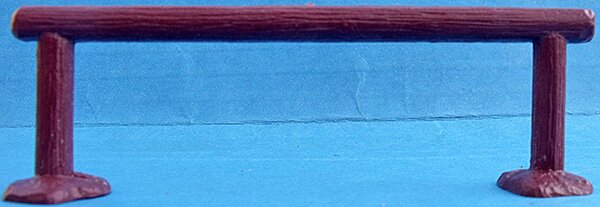 |
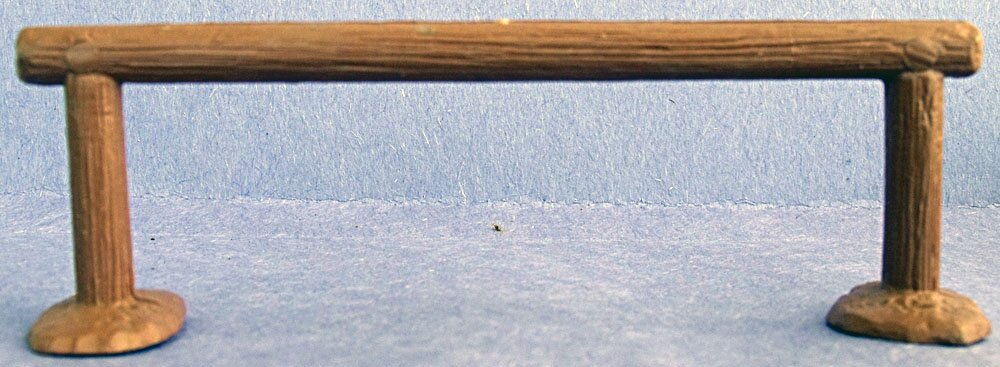 |
| 10. Spinning wheel | 11. Hitching post in maroon color |
11. Hitching post
in light brown color
|
10-piece outdoor stockade group (makes 8 items)
PL-351
This group first appeared in Fort Dearborn playsets in 1951. Based on later use in numerous Wild West playsets, it has come to be known as the stockade or Fort Apache outdoor accessory group. The pieces were made in brown or gray hard plastic.
The dip well and cooking fire are particularly fragile pieces. Each is a 2-piece item with a base and upper portion, and the pegs on the upper portion that are inserted into holes on the base are frequently found broken today. On the other hand, many are found with the two pieces glued together. The small powder barrels are hard to break and now seem to be the most readily available piece in the group. The axes and anvils in stumps and log piles are also easily found today, because they also were included in other accessory groups.
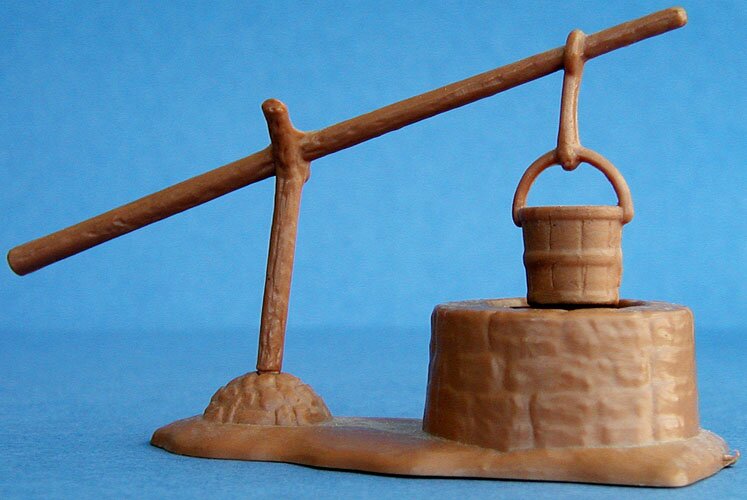 |
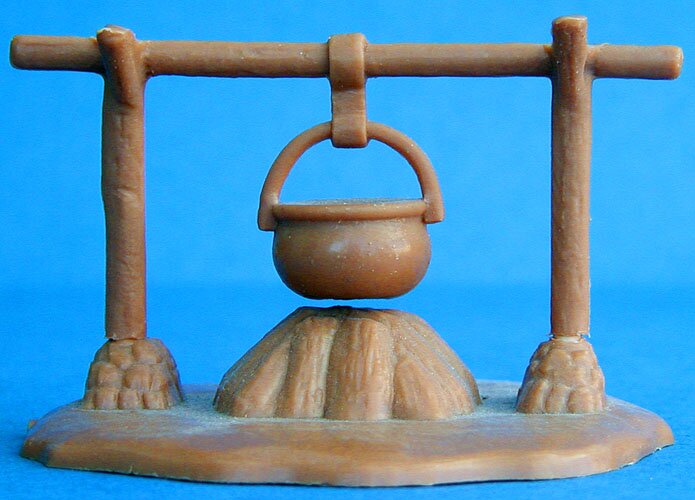 |
| 1. 2-piece dip well | 2. 2-piece pot hanging over fire |
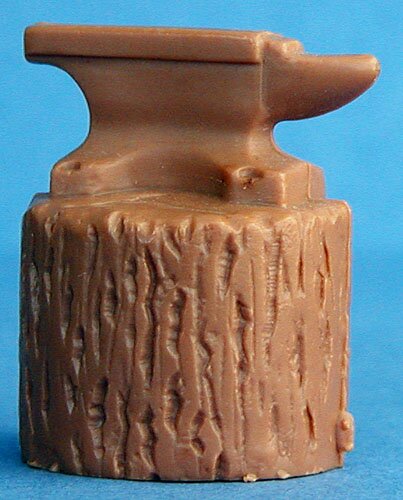 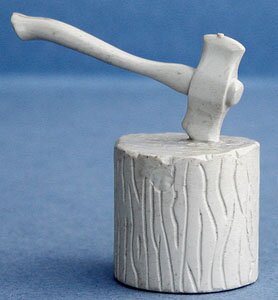 |
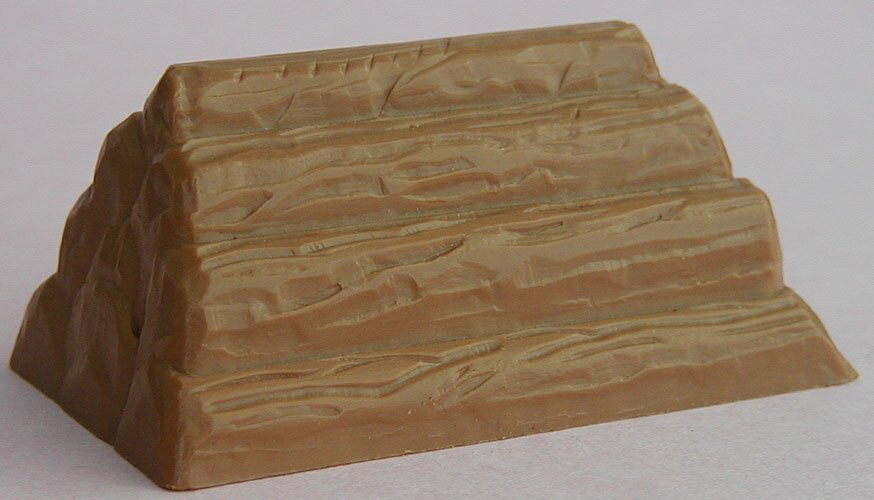 |
| 3. Anvil on stump 4. Axe on stump |
5. Log pile |
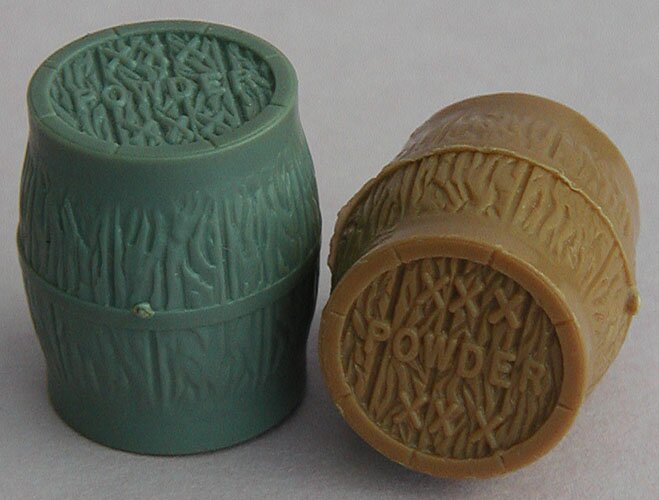 |
 |
| 7. Powder barrels (two) Closed top with XXX Powder XXX written on it. |
8. Butter churn |